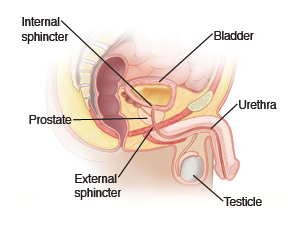Urinary Incontinence (Male)
We understand that gender is a spectrum. We may use gendered terms to talk about anatomy and health risk. Please use this sheet in a way that works best for you and your provider as you talk about your care.

Urinary incontinence means not being able to control the release of urine from the bladder.
Causes
Common causes of urinary incontinence in men include:
Other things that can cause incontinence are:
-
Nervous system diseases
-
Diabetes
-
Sleep apnea
-
Urinary tract infections
-
Prostate surgery
-
Pelvic injury
Constipation and smoking have also been identified as risk factors.
Symptoms
-
Urge incontinence (overactive bladder). This is a sudden urge to urinate. It occurs even though there may not be much urine in the bladder. The need to urinate often during the night is common. It's due to overactive bladder muscles.
-
Stress incontinence. This is urine leakage that you can't control. It can occur with sneezing, coughing, and other actions that put stress on the bladder.
Treatment
Treatment depends on what is causing the condition. Bladder infections are treated with antibiotics. Urinary retention is treated with a bladder catheter.
Home care
Follow these guidelines when caring for yourself at home:
-
Don't have any foods and drinks that may irritate the bladder. This includes:
-
Chocolate
-
Alcohol
-
Caffeine
-
Carbonated drinks
-
Acidic fruits and juices
-
Limit fluids to 6 to 8 cups a day.
-
Lose weight if you are overweight. This may reduce your symptoms.
-
If advised, do regular pelvic muscle-strengthening exercises such as Kegel exercises.
-
If needed, wear absorbent pads to catch urine. Change the pads often. This is for good hygiene and to prevent skin and bladder infections.
-
Bathe daily for good hygiene.
-
If an antibiotic was prescribed to treat a bladder infection, take it until it's finished. Keep taking it even if you are feeling better. This is to make sure your infection has cleared.
-
If a catheter was left in place, keep bacteria from getting into the collection bag. Don't disconnect the catheter from the collection bag.
-
Use a leg band to secure the catheter drainage tube, so it does not pull on the catheter. Drain the collection bag when it becomes full. To do this, use the drain spout at the bottom of the bag. Don't disconnect the bag from the catheter.
-
Don't pull on or try to remove a catheter. The catheter must be removed by a healthcare provider.
-
If you smoke, stop. Ask your provider for help if you can't do this on your own.
Follow-up care
Follow up with your healthcare provider, or as advised.
When to get medical advice
Call your healthcare provider right away if any of these occur:
-
Fever over 100.4ºF (38°C), or as directed by your provider
-
Bladder pain or fullness
-
Belly swelling, nausea, or vomiting
-
Back pain
-
Weakness, dizziness, or fainting
-
If a catheter was left in place, return if:
Online Medical Reviewer:
Marc Greenstein MD
Online Medical Reviewer:
Raymond Kent Turley BSN MSN RN
Online Medical Reviewer:
Rita Sather RN
Date Last Reviewed:
6/1/2022
© 2000-2025 The StayWell Company, LLC. All rights reserved. This information is not intended as a substitute for professional medical care. Always follow your healthcare professional's instructions.